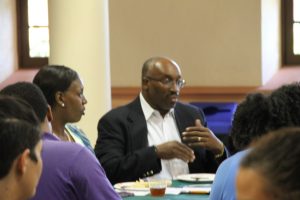Stetson celebrated Diversity Week with student-led events
By Brielle Tucker
Stetson University College of Law celebrated Diversity Week in honor of the American Bar Association’s Diversity Day with a series of events designed to provoke discussions about how to improve diversity and inclusion on the law school campus, as well as how to address implicit bias in the legal profession.

Students led the discussion during the “Black in America” event on the Gulfport campus. Photo by Brielle Tucker.

Associate Dean Darryl C. Wilson talked with students during the presentation on “Shades of Grey: Colorblind Jurisprudence” on March 2 in the Great Hall. Photo by Brielle Tucker.
At Stetson, organizations partnered to host interactive discussions, questions of the day, and panels. Events included the March 1 “Black in America” event sponsored by the Black Law Students Association. This event featured student-led discussions on various topics impacting the black community, from incarceration to misappropriation.
Throughout the week, students were asked questions by the Diversity Committee on the significance of diversity on campus, or how diversity can be improved on campus. Students were also encouraged to participate in the Implicit Bias Survey conducted by Harvard Law.
The week continued with the March 2 event, “Shades of Grey: Colorblind Jurisprudence,” co-sponsored by the Hispanic Bar Association, Black Law Students Association, and Pillars. Students participating in the event were asked to assume an identity drawn through a lottery and answer questions about the appropriateness of colorblind theories, color-conscious practices, and the impact of implicit bias.
“Colorblind jurisprudence refers to the developing interpretation of the Equal Protection Clause as applied to the Civil Rights Act of 1954 and the Voting Rights Act of 1965. This constitutional application of colorblindness became popularized during the nineties, and was widely debated as the U.S. Supreme Court began to redefine equal protection in affirmative action practices,” said student Alexis N. Turner Garris, whose research conducted during Professor Judith Scully’s course on Race and American Law was central to the presentation.
“I hope that those in attendance left feeling empowered to engage their peers in discussions regarding race,” said Garris. “But, I really hope that my peers feel a sense of relief knowing that they are not the only ones confused by the stark contrast between the Supreme Court’s theoretical, colorblind approach to racial issues, and the color-conscious approach taken within the criminal justice system and our everyday life.”
The week wrapped up with a student discussion entitled, “Implicit Bias and Diversity: From the Personal to the Professional.” The event centered around understanding how implicit bias may affect the legal profession.
Post date: March 8, 2017
Media contact: Kate Bradshaw
[email protected] | 727-430-1580